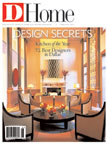 |
| HOME AWAY FROM HOME: A mix of vibrant color—turquoise, yellow, green, and magenta—works well in this sun-drenched lake house living room, as does the melange of furniture eras and styles. |
On Golden Pond
Color wizard Eric Prokesh breaks the rules to conjure an elegant Mediterranean getaway.
 |
| COLORWAYS: New paint, trim, and exterior details were all it took to transform a 1970s Spanish-style house into a sunny Mediterranean-inspired escape. |
The look was certainly more Brady than Brittany. Five years ago, when Dallas interior designer Eric Prokesh first saw his parents’ new purchase, a 1970s-style lake house, he sauntered across the rust-colored shag carpet, up the stairs with cheap iron railings, and peered out of its tiny, mean windows to a spectacular view of Lake Palestine below. Many would have pronounced the place hopeless after seeing its gaudy, fake-rock fireplace stretching up to the vaulted ceilings 20 feet above. But Eric imagined great possibilities and embarked on a three-year redo. “It has good bones,” he says today, sitting in the living room of his chic Highland Park house, the walls painted in flat, intense turquoise. And that’s Eric’s first rule of decorating: imagine the house naked.
Stripping the stairway of the tacky wrought-iron rails, Eric designed a replacement in wood, with architectural details more in keeping with the South of France sensibility he wanted to evoke. He replaced the awful shag carpet with terra-cotta tiles in oversized 16-inch squares or hexagons, both traditionally used in Mediterranean villas and country homes. The small windows were banished and replaced with dramatic scene-stealers, lined up side-by-side.
All of which illustrates Eric’s second rule: work with what you’ve got. “This was originally a Spanish-style house,” he says. “The idea was to transform it with paint, shutters, and simple things like that to make it look more Mediterranean.” This sort of Provence/South of France transformation was not only possible but also relatively easy because the exterior was stucco and the roof was red tile. But the work-with-what-you’ve got idea was also used inside. In the bedroom, sea-foam green hues were pulled from the set of Italian linens that his mother already had. Eric added draperies of turquoise toile and a turquoise-striped silk on a Biedermeier chair.
Which brings us to the third rule: know the rules, then go ahead and break them. Like Biedermeier and blue silk, Eric paired up other unlikely mates throughout the house. He updated his mother’s country French furniture collection by mixing it with art deco pieces and vibrant color, an idea borrowed from French design trends. “It’s not so traditional,” he says of the overall look. “With French pieces, people get obsessive and end up trying to be period or faithful, and it looks uptight—you end up losing the spirit. In the dining room, for instance, we used art deco chairs covered in orange and yellow Noblis cotton plaid—a jazzy French fabric—with an 18th-century Brittany vaisselier. There’s sort of a play between urban and country.”
 |
| Eric pairs more primitive, rustic designs and materials such as the custom-designed wooden railing in the gallery above the living room and the oversized terra-cotta tiles with luxe details quality fabrics, clean-lined furnishings, and wonderful antiques—to bring both refinement and ease to this interior. |
The reason Eric’s mix-and-match approach works is simple. Like Simon and Garfunkel, it’s all about creating harmony, which is also the fourth rule. “Everything has to work together so that no one thing is screaming for attention,” he says. “People end up focusing on color in my designs, but if you paint it all white, it would still be okay. It’s not completely dependent on color for its effects. It’s balanced. I care about things as a whole.” His parents’ house clicks, visually, because the look is clean. “There are few objects,” he says. “It’s a more pared-back look. That’s mainly what I do—get people to part with stuff. I mean, a woman wouldn’t go out wearing a jacket, scarf, gloves, a hat, and lots of jewelry. Well, she might. But that’s another story.”
And the fifth and final rule: there are no rules. “I think it’s about fun and delight,” he says. “With any rule that is an iron-clad rule, there are going to be a hundred exceptions. Like light colors making rooms look bigger is totally false. I owned a condo, and when I primed out the walls and started putting layers on it, a deep blue, it looked bigger.”
Viewing this space, alive with color and in combinations many people would never dare to try, makes it impossible to ignore the thing that Eric has become most known for—his wizardry with color. Color moves him, causes him to leap out of his chair on a lazy Saturday afternoon in search of a complement—or contrast. “I have a client who painted a room a dusty lilac color,” he says, disappearing into his office. He returns with a bolt of iridescent green silk and holds it up next to a lilac border in a framed black-and-white print. “I discovered this color harmony a year ago, looking up at the Sistine Chapel. This purple/green harmony runs all the way through it. One of the most studied pieces of art in the world—I find inspiration everywhere.”





